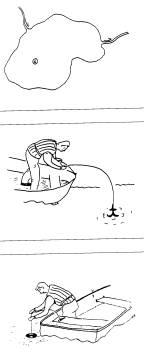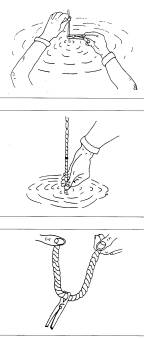The method described below is that of the Wisconsin Department of Natural Resources Self-Help Lake Monitoring Program, as modified for use by CLAM, the Ohio Lake Management Society’s Citizen’s Lake Assessment and Monitoring volunteer program. It contains elements of the procedures commonly used throughout the country. This method would be used if no viewscope is used. If a viewscope is used, the readings should be taken from the sunny side of the boat. Dip-In comments are added in italics.
For more information on disk design and sampling procedures please visit our Secchi Disk Methods page.
Please note: this procedure is presented for information only and is not a recommendation of the Dip-In. It should be considered for use only by new programs. Volunteers or coordinators should not change established procedures without careful consideration because of the potential of data loss.
Diagrams courtesy of the Wisconsin Department of Natural Resources Self-Help Lake Monitoring Handbook, 986.
Methods Used in Other Volunteer Monitoring Programs (edited from Carlson and Simpson 1995)
Below are methods used by some monitoring programs to measure Secchi depth. These methods are given without comment or recommendation as to whether the procedures are appropriate or correct. The reader should use this section to gain insight on how other programs are using the technique, and then combine those insights with the other discussions in the chapter to decide on an appropriate method for your program.
Volunteer Lake Monitoring: A Methods Manual
The EPA Volunteer Lake Monitoring manual (Simpson, 1991) suggests the use of a black and white Secchi disk and a marked line. The disk is lowered on shady side of boat and observed until it disappears. The disk is then moved up and down until the single point of vanishing and reappearing is found. A clothespin is attached to the line at this point, and the distance measured. Repeated measures by the volunteer is suggested as a quality control check. The average of two measurements is recorded.
Florida
Volunteers in the Florida Lakewatch program use a black and white disk lowered on the downwind side of the boat. The volunteers are urged to use their own shadow to minimize glare. They should not wear sunglasses. The vanishing point of the disk is found by lowering the disk out of sight and then raising it slowly until it can be faintly seen.
Florida has made a comparison between measurements made by the volunteers and made by professional working on the same lakes. The nature of the sampler (volunteer or professional) accounted for less than 1% of the variation in the relationship. More important sources of variation were lake to lake differences (62%) and seasonal differences (20%), and station differences (16%) (Canfield 1991).
Illinois
The Illinois volunteer program uses a black and white disk. Volunteers are urged to take readings as close to mid-day as possible or at least to measure transparency at the same time of day. Volunteers average the depths of the disappearance and reappearance of the disk. The readings are taken on the shady side of the boat with sunglasses removed.
Indiana
The Indiana volunteer program uses a black and white PVC plastic disk made at Indiana University. Measurements are made on bright, calm days, between the hours of 10:00 AM and 4:00 PM at a single lake location. The same lake site is used for all measurements on a given lake to promote consistency. Some volunteers also monitored their lakes at other locations as well, but these measurements were not reported (Jones, et al. 1992). The method for taking the Secchi depth reading is that described in the Wisconsin Self-Help Lake Monitoring program (see below).
Minnesota
The Minnesota Citizen Lake-Monitoring Program uses the all-white Secchi disk described by Shapiro et al. (1975). The volunteer is asked to make readings between 10 a.m. and 3 p.m. on bright, calm days. The disk is lowered over the shady side of the boat and the volunteer is asked to remove sunglasses. The depth of disappearance and reappearance of the disk is averaged, and the depth is measured to the nearest 1/2 foot. The line is marked. Dacron, or other polyester material, is recommended for the line because nylon has a tendency to stretch when wet, as well as being adversely affected by repeated exposure to sunlight.
New York
The Secchi disk is lowered into the water on the shaded side of the boat until it just disappears from sight. This depth is recorded to either the nearest 1/4 meter or to the nearest 0.1 meter or 1.0 foot on measured tape lines. The depth is then lowered an additional meter and raised until it reappears. These two values are then recorded separately.
Ohio (NEFCO)
This program uses a black and white disk. The volunteer is directed to remove any sunglasses and to lower the disk over the shady side of the boat. This program uses the methods first used in the Wisconsin Self-Help Lake Monitoring program (see below). Unlike the Wisconsin program, the Secchi depth is measured on the line with a yardstick. The line is marked, but there are only 5 foot markings in the range where Secchi depths would normally be found: the markings are only used to find the depth of the lake at the sampling site.
Ohio (CLAM)
The Ohio Lake Management Society’s Citizen Lake Assessment and Monitoring program uses the same type of disk and procedure as the Ohio NEFCO program, except the volunteers are given a 12 inch ruler rather than a yardstick to measure the depth.
Wisconsin
The Wisconsin Self-Help Lake Monitoring program requests that the volunteer remove sunglasses and lower the disk over the shady side of the boat. To obtain the Secchi depth, the volunteers mark the line with a clothespin at the depth of disappearance, then lower the disk well below this depth, then slowly raise the disk until it reappears. The Secchi depth is the midpoint between the depth of disappearance and the depth of reappearance. The clothespin is then moved to this mid-point. The Secchi depth is read to 1/4 of a foot.



